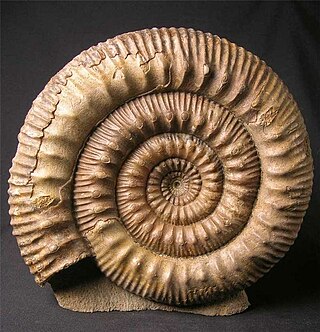
Stephanoceras is an extinct genus of Stephanoceratoid ammonite which lived during the Bajocian. It is the type genus of the family Stephanoceratidae.
Frogdenites is an extinct ammonite genus from the order Ammonitida that lived during the Middle Jurassic in what is now Europe, Canada, and Tibet. Frogdenites is included in the Otoitidae, a family which makes up part of the ammonitid superfamily, Stephanoceratoidea.
Docidoceras is an extinct ammonite genus from the order Ammonitida that lived during the Middle Jurassic. Docidoceras is included in the family Otoitidae which makes up part of the ammonite superfamily Stephanoceratoidea.
Ermoceras is a genus of ammonite belonging to the Thomboceratidae family of the Middle Jurassic found in deposites of central Arabia, Sinai, and Algeria with strong primary and secondary ribs and a single row of lateral tubercles; described as having a deep ventral groove
Otoites is the type genus of the ammonite family Otoitidae that live during the Middle Jurassic.
Lissoceras is an involute, smooth or finely vetrolaterally ribbed, ammonite with a blunt, un-keeled venter, included in the Haploceratidae, that lived from the Lower Bajocian - Middle Oxfordian in what is now Europe, south Asia, and southern Alaska.
Haplopleuroceras is a Middle Jurassic ammonite and likely member of the Hildoceratacean family Sonniniidae with which it shares the same sort of ribbing.

Stephanoceratoidea, formerly Stephanocerataceae, is a superfamily of middle- upper Jurassic ammonoid cephalopods within the order Ammonitida containing diverse forms, generally with sharp ribbing and complex suture lines. Aptychi are believed to be mostly granular (Granulaptycus) or concentrically ribbed on the surface (Praestriaptychus)
Otoidtidae: stephanoceratoid ammonitina from the early Middle Jurassic that begin as cadicones but become more planualte with age; derived from the Hammitoceratidae (Hildoceratoidea), probably through Erycites by way of Abbasites.

Hildoceratoidea, formerly Hildoceratacaea, is a superfamily of compressed or planulate ammonites, some tending to develop acute outer rims; generally with arcuate or sigmoidal ribs. Aptichus were found in place are double-valved.
Arkelloceras is an early Middle Jurassic Stephanoceratoid (Ammonitina) genus from arctic Canada, Alaska, and Siberia belonging to the family Otoitidae
Coeloceratidae is a family of ammonites belonging to the Eoderoceratoidea that lived during the Early Jurassic. Shells are evolute, tending to be broadly discoidal with depressed whorls bearing primary and secondary ribs that branch from outer lateral tubercles. Most of the included species have coronate inner whorls and outer tubercles only. In general, Coeloceratids resemble the Middle Jurassic Stephanoceras. Once regarded as the subfamily Coeloceratinae in the Eoderoceratidae, these ammonites are now given familial rank.

Perisphinctoidea, formerly Perisphinctaceae, is a superfamily of Middle Jurassic (Bajocian) to Lower Cretaceous (Barremian) ammonites, commonly with evolute shells with strong ribbing that typically divides about mid flank before crossing the venter.

Hildoceratidae is a family of ammonoid cephalopods from the Lower Jurassic, lower Pliensbachian to lower Bajocian substages, generally with strongly ribbed, involute shells. They are combined with the Hammatoceratidae, Graphoceratidae, and Sonniniidae to make up the Hildoceratoidea.

Perisphinctidae is a family of Middle and Upper Jurassic discoidal ammonites in the order Ammonitida. They have a shell morphology that is mostly evolute, typically with biplicate, simple, or triplicate ribbing. Large forms have simple apertures and smooth body chambers while small forms have lappets and ribbed body chambers.
Hammatoceratoidea, formerly Hammatocerataceae was a superfamily of middle Jurassic ammonites erected by Schindewolf in 1964 that combined the families Graphoceratidae, Hammatoceratidae, and Sonniniidae. The three families were previously included in the Hildoceratoidea, however subsequent classifications have moved the families back into Hildoceratoidea.
Erycitidae is a family of Lower and Middle Jurassic ammonites included in the Hildoceratoidea. The hammatoceratid subfamily Erycitinae is equivalent. Genera include Erycites (type) and Abbasites.

Hammatoceratidae is a family of lower and middle Jurassic ammonites included in the superfamily Hildoceratoidea.

Hammatoceras is a genus of ammonites belonging to the family Hammatoceratidae which lived during the Toarcian stage of the Early/Lower Jurassic between about 184 and 175 million year ago.
Bredyia is a genus of ammonites from the lower part of the Middle Jurassic, found in Europe and North America.





